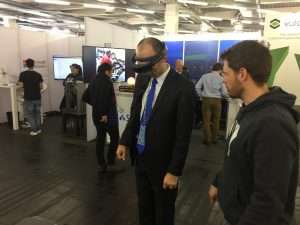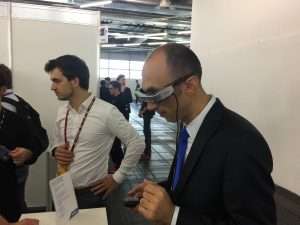Augmented Reality (AR) increasingly impacts Customer Purchases
As indicated by the exploration in the third quarter of 2015 (Mobile Path to Purchase, 2015) report; in today, up to 60 percent of mobile device users exclusively make their purchase decision online.
According to the research in the third quarter of 2015 (Mobile Path to Purchase, 2015) report. According to Forbes, 74 percent of people use their mobile phone to help them while shopping, with 79 percent making a purchase as a result. (ImpigeMobileStrategy.com, 2015). The mobile phone has become a convenient shopping destination for most of the online population. It can be said that mobile shoppers tend to engage in more casual browsing behavior.
Augmented Reality (AR) is the technology to create a “next generation, reality-based interface”. AR supplements the real world with virtual objects that appear to coexist in the same space as the real world.
AR has been used with developing technologies on mobile devices such as mobile phones, tablets etc. Besides this, mobile users make their purchase decisions on mobile ecosystem. New technologies such as QR code, mobile social media, mobile AR, etc. are attracted by the consumers. Thus, they tend to try, use and transform their behavior toward mobile purchase.
Mobile AR is the latest technology which has been used in a variety of marketing campaigns as a remarkable medium for consumers to interact with a brand.
On the other side, traditional e-commerce systems often cannot provide enough direct information or product interaction for consumers. AR methods and applications have been improved significantly over recent years; there has been little research related to usage of AR for magnifying e-commerce. The statement explained above is a deficiency about mobile purchasing.

(Picture: taken at the AWE + ISMAR Expo in Munich 2018)
Augmented Reality
Augmented Reality (AR) can be thought of as the “middle ground” between virtual environment and telepresence. According to AR system:
- Combines real and virtual objects in a real environment;
- Registers (aligns) real and virtual objects with each other;
- Runs interactively, in three dimensions, and in real time.
Augmented Reality (AR), an emerging Human-Computer Interaction technology, which aims to mix or overlap computer-generated 2D or 3D virtual objects and other feedback with real world scenes, shows great potential for enhancing e-commerce systems. The new approach gives customers a chance to “try” a product at home or in another usage environment. Augmented reality simulates enough of a “direct experience” with a product in order to make an impact on the user.
There have been a few real-world examples of augmented reality being used to enhance mobile shopping processes. There are AR platform companies such as Layar, Wikitude, Vuforia which supply mobile AR project design tools for marketers. Since the beginning of 2010’s some mobile AR commerce projects (applications) were designed with these tools such as AR application for Publishers Weekly magazine, Mr. Porter the online retailer, Ikea the furniture retailer, Mercedes-Benz, Audi etc.
All mobile AR applications intent to change consumers’ behavior toward their product or service. Overall results of the study will show that the AR mobile commerce system can help customers make better purchasing decisions.

(Picture: EPSON glasses being tested by BBT Editor Eren Ünlü at the AWE EU 2018)
Image Interactivity Technology (IIT)
Interactivity is regarded as an important feature for e-commerce ecosystems to attract consumers’ intention. The significance of interactivity is increasing in mobile commerce environment. Interactivity is termed “image interactivity”. With respect to Image Interactivity Technology or IIT, it is defined as “web site features that enable creation and manipulation of product or environment images to simulate actual experiences with the product or environment. Such as, virtual reality technologies fully involve online consumers inside a digital environment.
According to online retailers, they make efforts to treat their visitors/customers well in terms of incorporating advanced image interactivity technology (IIT) to provide 3D virtual experiences and facilitate viewers to simulate the actual experience with the product or environment. And it is found that 3D presentations of products outplayed 2D presentations to increase perception of indirect (virtual) product experience online. IIT allows customers to select images of products and body attributes meeting the customer’s individual specifications, then see what the products would look like.
In accordance with former studies about IIT factors’ effects Augmented Reality technology allows consumers to zoom in on product features, rotate and view the product from different angles and view the product in various colors on a virtual model created to imitate consumers’ appearance. With image interactivity technology (IIT), product’s design features, background, context, viewing angle or distance can be changed by the user and the product’s features on the digital environment can be visually experienced, product information through visual indications can be strengthened.
Telepresence
Telepresence is described as the experience produced by a computer-mediated environment, such as trying on store products produced by virtual modeling technology. To describe the perception of the realism of a computer-mediated experience, telepresence is defined as a sense of presence in a mediated environment.
“Presence refers to the natural perception of an environment and telepresence refers to the mediated perception of an environment.”
In order to the explain telepresence, a sense of presence in a remote environment, is used to examine the process by which media characteristics influence consumer responses. Besides, telepresence is affected by level of image interactivity technology. The concept of telepresence can thus be applied to consumers when they interact with products presented in 3D. More specifically, telepresence requires that how closely the quality and quantity of simulated sensory information about the product and the simulated ability to interact with the product approximate the sensory information from interaction with the product in the real world.
The two major factors of telepresence are interactivity and vividness. Interactivity refers to consumer interaction with products; while vividness represents the representation richness of product demonstrations. It was found that there is a positive impact of visual product experience or telepresence on online consumer responses and it was found that telepresence affected consumer responses indirectly by simplifying product knowledge.
Purchase Intent
Purchase intentions were examined to explain behavioral responses. AR produces a higher level of product knowledge caused by virtual experience conditions and unveil a significantly positive effect on attitude and purchase intent.
Therefore, the emergence of purchase intention caused by mobile marketing activities is on account of product knowledge and attitude.
